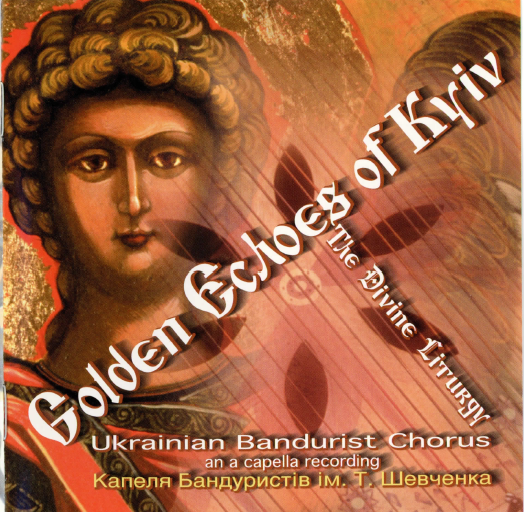Golden Echoes of Kyiv
Golden Echoes of Kyiv
 Artistic Director: Oleh Mahlay
Artistic Director: Oleh Mahlay
Recorded at the St. Josaphat's Ukrainian Catholic Church, Warren, Michigan 2001
About the Chorus
The history of the Ukrainian Bandurist Chorus can be traced directly to the 12th Archeological Congress in Kharkiv, Ukraine, in 1902. The question of forming a professional orchestra of bandurists was first presented here by Hnat Khotkevych, a prominent writer, ethnographer and composer. He provided stimulus for a renewed interest and remarkable growth in the bandura's popularity at the beginning of the 20th century. As a result, amateur bandura ensembles rapidly formed throughout the country.
The first professional bandurist chorus was formed in Kyiv in 1918 during the height of the country's brief period of independence. Under the direction of bandura virtuoso Vasyl Yemetz, the first chorus had 15 members. Another such chorus, in Poltava, Ukraine, was formed in 1925 under the direction of Volodymyr Kabachok.
The mid-1920s were marked by a period of resurgence of Ukrainian arts and culture. The Chorus developed into a professional touring troupe. As the Chorus membership, expertise, and repertoire were continually refined and enhanced, the bandura was transformed from a folk to a classical concert form.
The Chorus' history rapidly evolved into a turbulent one. The ideals of the bandurist – God, truth, freedom, and human dignity heralded through song – were a threat to the then-newly formed Soviet Union. Under Joseph Stalin's rule, artists and intellectuals were arrested, exiled or executed in an attempt to eradicate every remnant of Ukrainian culture.
Hnat Khotkevych was executed in 1938 in Kharkiv and his compositions were banned throughout the Soviet Union. Many conductors, chorus members, and blind bandurists-minstrels were also accused of enticing the populace to nationalism, and as a result were executed. In 1935, the remaining members were forced to reorganize into the State Bandurist Chorus of the Ukrainian SSR.
In the years that followed, the Chorus was exploited and persecuted by both the Soviets and the Nazis. It was not until 1949, that through the assistance of the allied forces, many of the Chorus' members immigrated from refugee camps to the United States. Many established a home base in Detroit, Michigan.
Freedom was a great blessing, but not without its difficulties. Most of the members, in order to support their families, had to learn new skills that were often unrelated to their musical ability and experience. Approximately 90 percent joined Detroit's automotive industry labor force. This, however, did not prevent the bandurists from launching a series of concerts in their newly adopted homeland. The Ukrainian Bandurist Chorus was reborn. It currently has members from across Canada and the United State.
External Links
- Ukrainian Bandurist Chorus website
- Ukrainian Bandurist Chorus history
- Hnat Khotkevitch
- Vasyl Yemetz
- Volodymyr Kabachok
Source: CD Brochure


